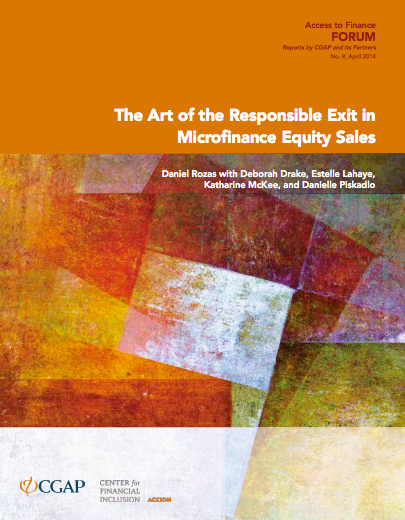
The Art of the Responsible Exit in Microfinance Equity Sales
Published: April, 2014
Equity as a funding instrument is particularly important to responsible development of financial markets. At its core, it supports the growth and diversification of microfinance institutions (MFIs) and other financial institutions that serve the poor, and it is especially vital to the expansion of deposit services.
But beyond that, equity holdings can add value when paired with active governance. First, they offer development-minded shareholders the opportunity to provide leadership to partner MFIs, including guidance to ensure that the overall strategy and specific products and practices are responsible. Second, they can promote responsible development of the broader market to the extent that they demonstrate the viability of responsible MFI business models (including by sharing relevant information on partner MFIs’ performance with other market actors) and crowd in additional investors with goals and funding types that are appropriate for microfinance. This point is especially important for development finance institutions (DFIs), which are owned by donor governments and thus are mandated to be catalytic and “additional” in promoting private sector development.
Most microfinance investment intermediaries (MIIs) and DFIs have committed explicitly to do right by clients through industry initiatives such as the Smart Campaign and the Principles for Investors in Inclusive Finance (PIIF), which urge and support them to choose partners carefully and integrate specific responsible finance practices throughout their investment processes.
As the holdings of MIIs and DFIs mature, the sale of equity stakes is becoming an increasingly important task and one that requires consideration of additional dimensions of responsible finance and responsible market development. When investors that seek to be socially responsible exit, they face the challenge that they will give up their right to help oversee or govern the investee. To what extent can—or should—investors seek to ensure that the sale of their stakes in MFIs will result in ongoing responsible behavior by their (former) partners and new owners and even contribute to healthy development of the overall market? And what if they reinvest the proceeds from a sale into younger missionfocused institutions and underserved markets: is such an exit then automatically socially responsible?
Equity exits are not a new phenomenon in a sector where the first funds were created well over a decade ago and a number of sales have already happened (Glisovic, Gonzalez, Saltuk, and Rozeira de Mariz 2012). They are also expected to accelerate. According to MicroRate/Luminis, between 2014 and 2016, at least two equity and six hybrid funds worth nearly $600 million are scheduled to mature.
In this context, this paper seeks to explore the concept of a responsible exit along four strategic decisions: (i) the timing of the equity sale, (ii) buyer selection, (iii) the governance and use of shareholder agreements to achieve social objectives, and (iv) how social and financial returns are balanced when selecting among bids. We also examine how DFIs can use exits to encourage responsible market development given their particular role as publicly funded entities. We interviewed more than 40 representatives from MIIs, nongovernment organizations (NGOs), DFIs, MFIs, and merger-and-acquisition (M&A) specialists to capture their experience, perspectives, and emerging lessons on equity sale transactions. In addition, we conducted six case studies of equity exits, which are described in detail in the appendices.
This paper is not intended to be prescriptive. The practice of selling equity in MFIs is still evolving, and the complexities of the transactions make each sale unique. Rather than setting out specific guidelines, we hope to draw on investor experiences to highlight key exit-related decisions for MIIs and DFIs, and in so doing, we hope to spur a focused debate on how to exit in such a way that the interests of investors, MFIs, and their clients are balanced.



